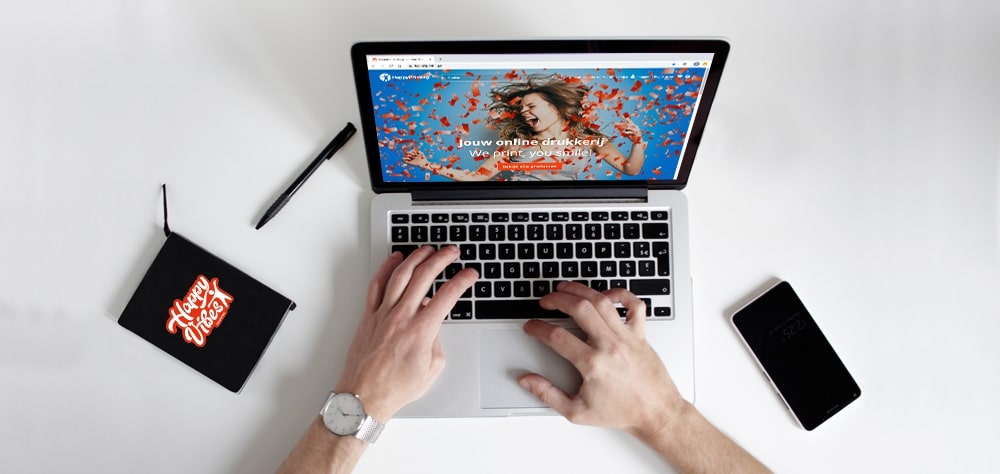At GleePrinting we know, like nobody else, how easily something can go wrong when ordering printed materials. As a result, a great deal of printed matter enters directly and unnecessarily into the waste container. This is not only a waste of printed materials, but also a waste of your time. To prevent you from running into surprises along the way, we will discuss 9 tips that will help you deliver a good printing file!

Would you rather use an online editor instead of delivering your own file? No problem! With our Online editor you can easily create PDF-files for any product on our site. In this blog we explain, step by step, how our online editor works.
Happy Tip #1 Using the correct file type
At GleePrinting we, unfortunately, do not accept print files supplied in Powerpoint, Word or other Microsoft Office applications. We would like to receive your print files as PDF, or in the case of large files as ZIP or RAR.
Happy Tip #2 Use our Examples and templates
As you may have noticed, we offer a wide range of printed products to our clients. All these different products have their own specifications and sizes. For all these products we have made templates, which give a clear visual illustration. This not only makes it easier for you to create a good printing file, it also makes it easier for us to print your file!
Happy Tip #3 Don’t forgot to take the boxes into account
If you use an application from Adobe, you can use various layout frames when making your files. These 'boxes' have different functions which, when wrongly used, can have a negative effect on the printed result;
- Cropbox; this is the outer visible frame. Everything outside this box is not visible in a regular pdf.
- Bleedbox; it is used to display the bleed / bleed frame. It is up to you how much bleed you use, but we require a minimum of at least 3mm to be able to deliver correct printed matter.
- Trimbox; this box is the edge of the finished format and is also called the 'digital cut line'.
- Mediabox; the most important format is normally done within this framework. Make sure that all content is important within this framework. Normally, the media box is set to 5mm within the trimbox.
Handy Tip #4 Make sure the fonts are included in the file
The fun thing about designing your own products is that you can choose everything youself. This also applies to the fonts. However, due to the countless options of fonts it is possible that sometimes your chosen font is not available at the printer. To prevent the scenario in which another font is used, you can include the fonts in the file.
Happy Tip #5 Or convert fonts to outlines
It is also possible Convert fonts to outlines. The letters are then replaced with lines and then there is no font-related information. A disadvantage of this however can be that no more changes can be made afterwards, since the letters have become lines.
Happy Tip #6 Using the right colour coding
In full color printing, colors are made by a combination of CMYK. At CMYK there is a maximum of 280% color occupancy. If higher, the color is automatically reset to 280%. This is to prevent the ink from getting too wet and transferring to other printed matter, which can cause unsightly stains.
Using PMS? Always make sure PMS is really PMS and not a mix on your palette. It is okay to choose a tint of a PMS color, in this case the density of the ink is reduced and the color is lighter. For both CMYK and PMS it applies that you should always keep a minimum of 10% of 1 color to ensure no loss of color.
Happy Tip #7 The right use of transparency
When making a file, the result in your layout program is as you wish, however the printed version can experience strange distortions. The pressing technique is not always able to print the image 1-to-1 as you deliver. For transparencies we therefore recommend that you flatten them if possible (flattening) and merge the layers to 1 layer. This prevents possible, undesirable results in the printed matter.
Happy Tip #8 Images with the best quality
To guarantee the quality of the printed materials we ask you to deliver your images to the file with a minimum resolution of 300 DPI. With larger images, such as posters, advertising signs etc, you can deliver images with a lower DPI with a minimum of 150 DPI.
Happy Tip #9 Watch out for the use of guidelines and contour lines
It can be very useful to use auxiliary lines or punching forms, so that it is easier to see how the printed material looks finished. Unfortunately, these tools are printed if these shapes and/or lines are in the file. If you want to show these shapes for illustration, make sure that you submit 2 files; 1 with and 1 without the tools. Give the file a clear name so that there is no misunderstanding about which file must be printed.
These tips help you deliver a good printing file. We will do the rest, so in the end you can enjoy your product.
Do you have any other questions? Don’t hesitate to contact us! We are here to help you and make this an easy ordering experience.
We print, You smile